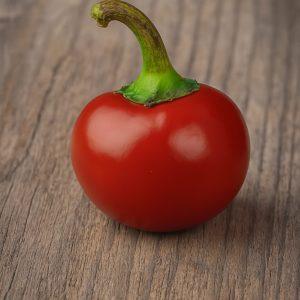Description
Product Name: Carolina Reaper Seeds
Cultivar Name: Carolina Reaper
Species: Capsicum chinense
Common Names: Reaper, Smokin’ Ed’s Carolina Reaper, Worlds hottest chilli
Type: Hybrid
Origin & Lineage
Geographic Origin: The Carolina Reaper was developed in Fort Mill, South Carolina, USA. Although its genetic roots trace back to South Asia and the Caribbean, its final form was stabilized in the southeastern United States. The species Capsicum chinense, to which it belongs, is native to the Amazon basin and was later dispersed throughout the Caribbean and tropical Americas.
Cultural Significance: While the Carolina Reaper does not have deep traditional culinary or ritual roots like some heirloom varieties, it has become a cultural icon in the modern chili community. It is frequently featured in competitive eating contests, viral challenges, and extreme culinary experiences. Its notoriety has elevated it to a symbol of endurance and bravado among chili enthusiasts. Though not tied to folklore, its reputation has inspired a subculture of growers and consumers who treat it with reverence and caution.
Lineage / Hybridizer History: The Carolina Reaper was bred by Ed Currie, founder of the PuckerButt Pepper Company. The Carolina Reaper originated from a cross between a Pakistani Naga pepper (a variant of Bhut Jolokia) and a red Caribbean habanero from Saint Vincent. Initially labeled HP22B (Higher Power, pot 22, plant B), the pepper underwent years of selective breeding and stabilization. It was officially recognized by Guinness World Records in 2013 as the worlds hottest chilli pepper, a title it held until 2023 when it was dethroned by Pepper X. Currie’s breeding efforts focused not only on heat but also on flavor complexity, making the Reaper a dual-purpose cultivar for culinary and novelty use.
Heat Profile
Scoville Rating (SHU):
Average: 1,641,183 SHU
Peak: Up to 2,200,000 SHU
Perceived Heat:
Superhot to Hyperhot
Heat Characteristics: The Carolina Reaper delivers a delayed and escalating burn. Initial sweetness gives way to a searing heat that intensifies over 10–20 seconds, peaking with a prolonged sting that can last up to an hour. The burn is concentrated in the placenta and inner membranes, where capsaicinoid density is highest. Handling requires gloves and eye protection due to the risk of capsaicin burns. The heat is not only intense but also persistent, often described as “molten lava” by those who consume it raw.
Flavor Profile
Tasting Notes: Despite its ferocity, the Carolina Reaper offers a surprisingly nuanced flavor. The initial taste is sweet and fruity, with hints of citrus, tropical fruit, and subtle cinnamon or chocolate undertones. These notes are typical of Capsicum chinense cultivars and are especially pronounced when the pepper is used in small quantities or blended with milder ingredients.
Aftertaste / Finish: The sweetness fades rapidly, overtaken by a sharp, lingering heat. The finish is oily and pungent, with a residual bitterness that can be tempered through roasting or fermentation.
Ideal Pairings:
- Fruit-based hot sauces (mango, pineapple, papaya)
- Smoky barbecue rubs
- Fermented chili pastes
- Spicy jams and jellies
- Dairy-based dips (to counteract heat)
Pod Review: https://www.youtube.com/watch?v=1IkS4Y3ENYQ
Fruit Characteristics
Shape:
Bulbous with a pointed, scorpion-like tail
Size:
Approximately 4–5 cm long, 2–2.5 cm diameter
Color Stages:
Immature: green → Ripe: bright red
Wall Thickness:
Medium
Texture & Skin:
Wrinkled, bumpy, often blistered with a gnarled appearance
Plant Details
Growth Habit:
Bushy
Plant Height & Width:
Height: 90–150 cm
Width: 60–90 cm
Foliage:
Dark green, pubescent
Flower Color:
White
Days to Maturity:
90–120 days from germination to harvest
Yield:
Moderate – typically 30–50 pods per mature plant under optimal conditions
Cultivation Information
Seed Count per Pack:
5 or 10 seeds (Presoaking Chilli Seeds)
Germination Time:
7–14 days (Germinating Chilli Seeds)
Optimal Germination Temp:
25–30°C (Essential guide to ideal temperatures and humidity for chilli seed germination)
Light Requirements:
Filtered sun
Soil Preferences:
- pH: 6.0–6.8
- Well-draining loamy soil
- Rich in organic matter (Easy DIY soil mixes)
Storage Tips: Store Carolina Reaper Chilli seeds in airtight containers in a cool, dry place. Refrigeration is recommended for long-term viability. Avoid exposure to humidity or direct sunlight.
Other Reaper Cultivars: Magma Reaper, Purple Reaper, Brazilian Reaper, Golden Reaper, Reaper pink peach, Peach Reaper, Reaper purple peach, Yellow Reaper and choc reaper.
Notable Compounds
Capsaicinoid Content: High concentrations of capsaicin and dihydrocapsaicin, particularly in the placenta and locular tissues
Volatile Flavor Compounds: Limonene, vanillin, and trace esters contributing to fruity aroma
Anthocyanins / Pigments: No significant purple pigmentation; red coloration is due to carotenoids such as capsanthin and capsorubin
Culinary & Cultural Use
Traditional Uses: Although not traditional in indigenous cuisines, the Carolina Reaper has become a staple in modern extreme-heat culinary applications. It is used in:
- Ultra-hot sauces
- Fermented chili pastes
- Spicy jams and jellies
- Dry rubs and seasoning blends
Raw vs Cooked Flavor:
- Raw: Sweet and fruity with immediate heat
- Roasted: Enhanced smokiness and mellowed bitterness
- Pickled: Retains heat but gains acidity and complexity
- Fermented: Deep umami and softened pungency
Regional Dishes:
- “The Last Dab” hot sauce (popularized by Hot Ones)
- Reaper Squeezin’s (PuckerButt Pepper Co.)
- Carolina Reaper salsa with mango or pineapple
- Reaper-infused chili con carne
- Reaper pepper jelly served with cheese or meats
Storage / Drying / Preserving Tips:
- Drying: Use dehydrators at low heat to preserve flavor and potency
- Fermentation: Submerge in brine for 2–4 weeks for probiotic-rich sauces
- Freezing: Whole pods can be frozen for later use
- Powdering: Grind dried pods into fine powder for spice blends







Reviews
There are no reviews yet.